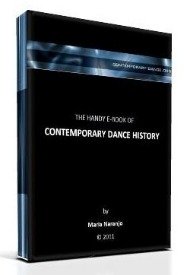Documents about how movement could be a mystical experience or a transcendental one.
by Paloma
(Colombia)
Dear Maria,
First of all, thank you for the blog and all your texts. They're so useful and easy to read! (and I'm sorry about my english, I'm just learning it right now).
I'm studying literature and my thesis is about travel literature. In fact, I would like to apply some concepts and theories of movement to shape my analysis. I read your texts about Laban's notation and I will look for the Bernard's books you recommended.
Do you have other references or documents about theory of movement in dance? Precisely, about how could movement be a mystical experience or a transcendental one.
I know it's a very specific question but any guidance would help me a lot.
Thank you!
Kindly,
Paloma
Comments for Documents about how movement could be a mystical experience or a transcendental one.
|
||
|
||
The handy e-book of CONTEMPORARY DANCE HISTORY:
The Dance Thinker is our occasional E-zine. Fill in the form below to receive it for free and join us.
Read:
"The Dance Thinker"
BACK ISSUES
Post contemporary dance announcements (workshops, auditions, performances, meetings and important news... it is free.)



